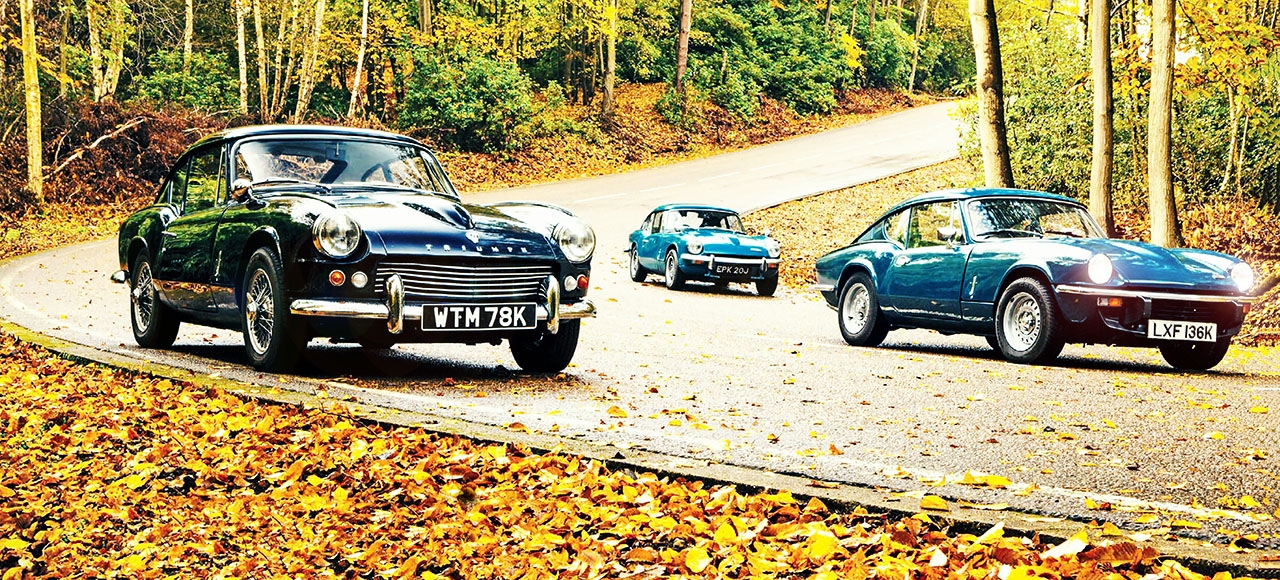
Triumph’s E-Type from £5000! Why the stylish GT6 is a bargain alternative to Jaguar’s icon. We sample three generations of Triumph’s GT6. Coventry’s baby GT James Page examines Triumph’s GT6 and discovers that it’s a fantastic car. Canley’s Super six. As the brilliant Triumph GT6 reaches its half-century, James Page gathers together Mk1, 2 and 3 to see why it is still such a great classic bargain. Photography Tony Baker.
For a company that built such a wide range of cars in such volumes, Triumph always had an individual streak. In many ways, of course, its products mirrored those of MG, its great British rival. Where Abingdon had the Midget, MGB and BGT, Canley put forth the Spitfire, TR4 and GT6. But while both firms made the very best use of in-house components that were shared with more humble machinery, Triumph – to a fault, you could say – always went about it in a slightly different way.

Each incarnation has its strengths, but the little Triumph remained a good-looking ‘mini GT’ throughout its eight-year production run.
In terms of the Spitfire and GT6 bloodline, much of that was due to the layout of the Herald saloon, which had been launched in 1959. Its use of a separate chassis was old-hat even then, and its swing-axle rear end not ideally suited to the sports cars that were to follow. Even so, unsung engineer Harry Webster was convinced that a two-seater based on that platform would be an effective rival to the likes of the Austin-Healey Sprite and forthcoming Midget, and he had Giovanni Michelotti create a prototype, which was codenamed ‘Bomb’.
Sadly, the project took a back seat as Triumph plunged into one of its periodic financial crises, only to be bailed out by Leyland in 1961. The Bomb was then turned into the Spitfire in double-quick time for a 1962 launch, Webster’s fertile mind already looking ahead and hoping to increase its appeal by developing a coupé variant. Having raised the idea at board level in August 1963, Webster went back to Michelotti and asked him to come up with something that shared as many panels as possible with the Spitfire. What the Italian produced was stylish, beautifully proportioned and, thanks to its hatchback rear, surprisingly practical.

Clockwise, from above: the Mk3’s deeper windscreen improved headroom; TR6 engine is a relatively common conversion and transforms the car; Mk3 was last of the line; squared-off rear is clear in profile – performance of this example is strong; wider 5.5in steel wheels. The different treatment for the rear lights was the most obvious change for the Mk3, with the chrome surround echoing the Stag and Spitfire MkIV.
The original intention had been to simply carry over the four-cylinder engine to create the ‘Spitfire GT’, but the 1147cc unit wasn’t man enough to cope with the coupé’s extra weight. The obvious answer was to drop in the Vitesse’s 1596cc straight-six but, although this started the process by which the new model was distanced from the Spitfire, it also failed to produce the required levels of performance. Instead, the 1998cc engine that was originally built for the Standard Vanguard Six and had recently been used in the Triumph 2000 was fitted, and that did the trick. The firm’s history with six-cylinder engines went all the way back to the 1931 Scorpion and its attempts to move upmarket. Thirty years later, and despite the fact that it could trace its origins to the 803cc ‘four’ that had been designed for the 1953 Standard Eight, it was the adoption of this engine that would serve to give the GT6 much of its undoubted character.
The public would be given a sneak preview of the coupé via the appearance in 1964 of a squadron of hardtop Spitfires at Le Mans. Contrary to long-held belief – no doubt fostered by Triumph’s own period GT6 adverts: ‘Bred at Le Mans to put you safely ahead!’ – the shape of the racers was derived from the nascent road car, not vice versa. In fact, their roofs were constructed using a mould that had been taken from Michelotti’s GT6 prototype.

There were other similarities. In 1964, those competition Spitfires used the 3.98:1 finaldrive ratio that the non-overdrive GT6 would later adopt, plus the same all-synchromesh gearbox. Only one of the three cars finished that year (ADU 2B, in 21st position); two out of four did so in ’1965, but Triumph cancelled plans to run a Spitfire with a heavily modified GT6 engine at the following year’s 24 Hours.
The new coupé made its debut at the 1966 Earls Court Motor Show. As dictated by manufacturing practicalities, the floorpans, bulkhead and doors were the same as those on the Spitfire, even if the layout of the luggage area meant that the fuel tank had to be redesigned and moved to the nearside rear wing.
Triumph had done a good job of giving the model a more sophisticated mini-Grand Tourer image, rather than the spartan sports car brief fulfilled by the Spitfire. Inside, for example, it was positively luxurious, with a full-width walnut dashboard, carpeting throughout and more comfortable seats. The dials, meanwhile, were arranged ahead of the driver rather than grouped in the centre of the fascia.
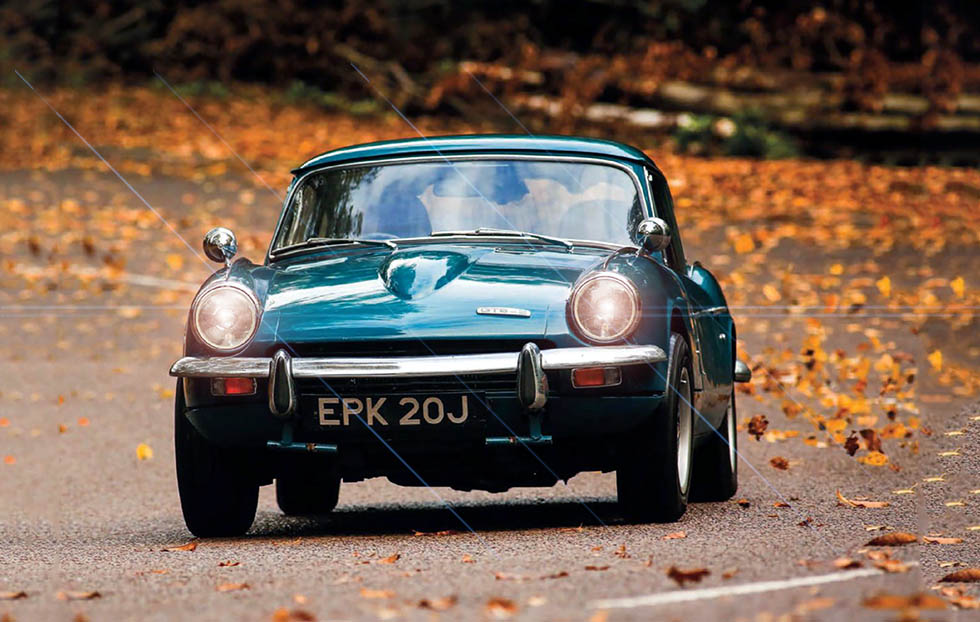
Visual changes were slight for the Mk2, with a higher front bumper and a revised grille. The bars below the overriders enable Titchen’s car to be towed.
The ‘six’ produced 95bhp – exactly the same as the MGB GT, which was perhaps the car’s most natural rival and which had been launched the previous year. And yet, as a small, affordable, six-cylinder two-seater coupé, the Triumph occupied a niche pretty much all of its own, giving those who couldn’t stretch to a Jaguar E-type a tantalising glimpse into that rarefied world. Or, as one road-tester put it: ‘A businessman’s express for the less-affluent businessman.’
The motoring press gave the new car a warm welcome. Despite Triumph’s best efforts to distance it from its four-cylinder sibling, there were the inevitable references to the Spitfire – Autocar rather damning that model’s status by stating that the GT6 was ‘essentially a Spitfire sports car’. Almost everyone recognised its good looks, performance and value for money, but there was the occasional word of warning over the Herald-derived swing-axle rear end. After its appearance on the saloon – as well as the Spitfire and Vitesse – that was hardly news to the Coventry engineers, and was addressed on the 1968 Mk2. In an attempt to calm the liftoff oversteer of the earlier car, the updated version used a lower-wishbone set-up with Rotoflex couplings between the halfshafts and the hubs. The wishbones themselves were reversed, with the double pivot outboard and the single mounting point inboard.
Beneath the bonnet, meanwhile, the ‘six’ gained a redesigned cylinder head and the TR250’s inlet manifold, which added up to a 9bhp increase in power. Inside, ventilation was improved so that occupants weren’t slowly baked by the heat from the engine, and there was even the option of a spectacularly useless rear ‘seat’.
‘The new GT6 Mk2,’ proclaimed the advertising copywriters. ‘More sting in the engine, more cling in the tail’. Certainly it was deemed to be much improved but, in the vital American market at least, sales began to slip after reaching their peak in 1968. Sadly, the Triumph didn’t live up to its own press as ‘The car that sells itself’.
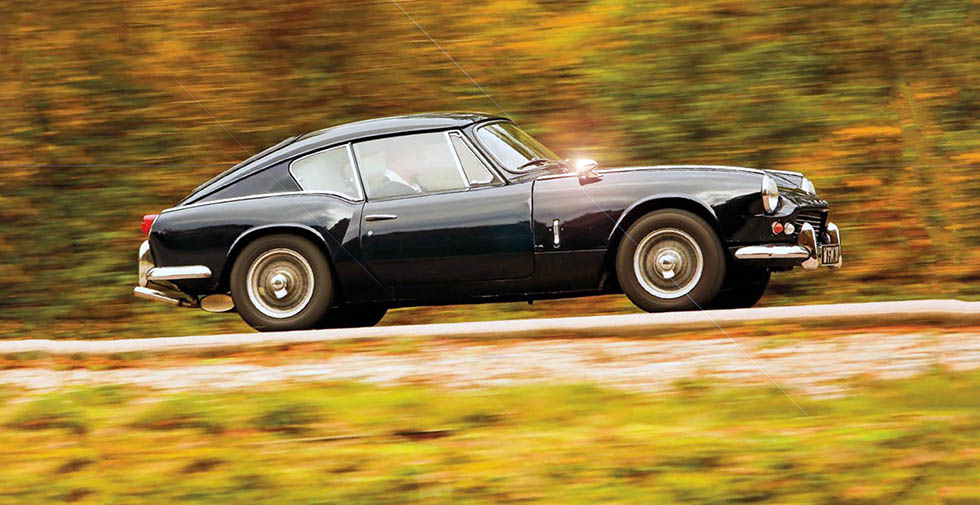
Spitfire origins are clear in the GT6’s profile, but the six-cylinder car was a far more sophisticated proposition than its back-to-basics sibling.
Canley nonetheless gave the model one last hurrah with the Mk3, which was facelifted along similar lines to the Spitfire MkIV and launched alongside it at the 1970 Turin Salon. There had been a design proposal kicking around that would have given this latest incarnation a completely new nose with pop-up headlamps, but in the end the biggest changes were at the rear. Stag-style tail-lights gave the car a very different look, while inside there were flush rocker switches in place of the earlier toggles, and the overdrive switch was relocated from the steering column to the gearknob.
It wasn’t enough to save the model; production stopped in 1973 after a final round of revisions that included dropping the Rotoflex rear end – by then, the GT6 was the only model using it – in favour of the Spitfire MkIV’s swing-spring layout. The combined effect of BL’s bean counters and US emissions regulations meant that the ‘six’ was slowly strangled over its final couple of years – Federal-spec cars were down to 79bhp for 1972 – but Triumph countered by throwing more and more standard kit at its little coupé, including Sundym glass and a brake servo. For the most part, the GT6 was saved the ignominious end that befell so many of its BL stablemates. Its looks, for example, were still mostly intact as production wound down.
The whole point of the GT6 was that it brought the glamorous world of six-cylinder GTs within reach of the man on the street, offering an ‘edge’ that its mainstream rivals struggled to match. The styling certainly helped. Compact at the time – and tiny by modern standards – it ticks all of the right boxes: long, curvaceous bonnet, fastback rear, perfect proportions. Combined with that sonorous engine, it really does make you feel as though you’re in something worth at least five times as much. The low driving position is suitably rakish, and you get a great view of the front wings and central ‘power bulge’ – necessary to clear the longer engine. The offset pedals are typical of many of Triumph’s cars, though.
The featured Mk1 and Mk2 both have the standard powerplant, which is smooth, remarkably subdued from within the cabin and, having plenty of torque, responds instantly and eagerly to throttle inputs. The gearbox feels pleasingly mechanical and the steering is nicely weighted. A wet, tree-lined road is not the ideal place in which to explore the in extremis handling differences between the two, but Neil Fletcher – the owner of the Mk1 – explains that he’s taken part in track days and covered countless road miles without being dispatched into the scenery. As with many cars that have a similarly lairy reputation, it would appear that much depends on how careless the driver is. At everyday speeds, at least, the first incarnation turns in well and doesn’t feel as if it’s going to swap ends. ‘Our’ Mk3 is a slightly different proposition. In period, the GT6 was ripe for modification, with SAH TriumphTune, for example, offering five stages that could give anything from 120bhp (hot camshaft, reworked head, six-branch manifold, upgraded carbs) upwards. You could even fit Tecalemit fuel injection or triple Webers.
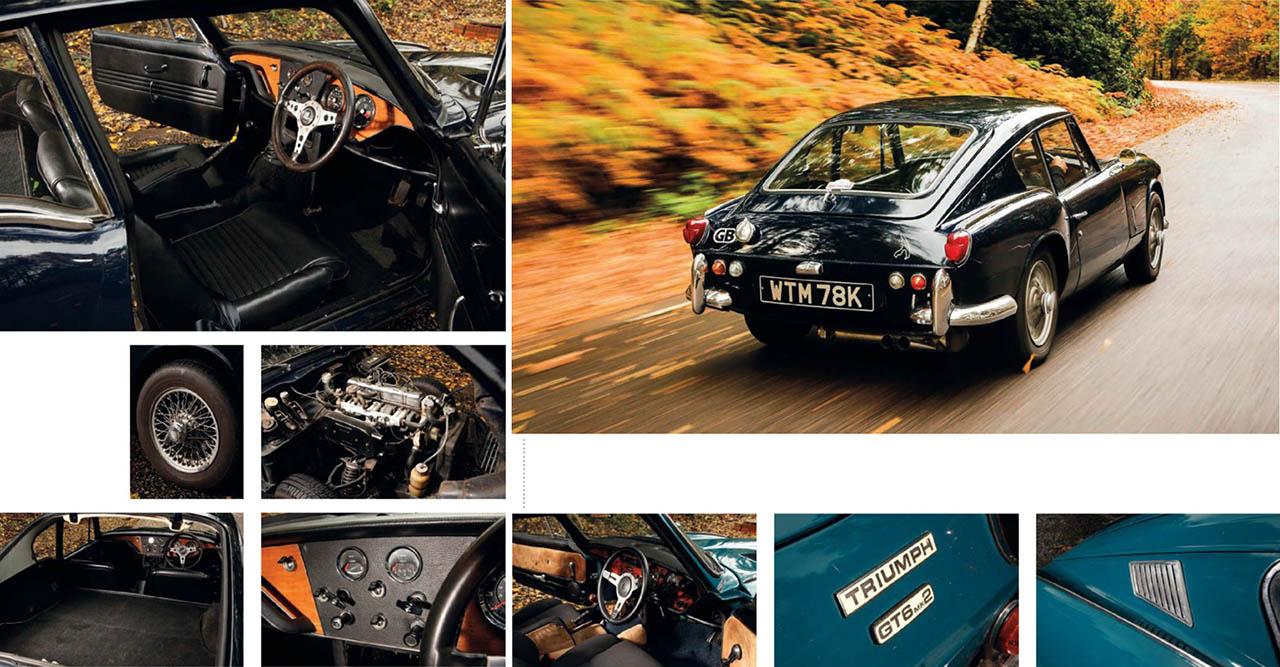
Clockwise, from above: snug cabin with fly-off handbrake; excellent engine-bay access; toggle switches for early cars; Michelotti’s coupé design is beautifully resolved; hatchback gives Triumph impressive practicality – the rear luggage deck is remarkably spacious.
The trend continues today, the fitment of Triumph’s 2.5-litre engine being a very popular conversion. Andy Carr has done just that, and the transformation is remarkable. Whereas the standard cars are smooth and relatively discreet, this Mk3 is gruff and forceful. It has loads of grunt, as you would expect, and feels beautifully sorted. You do wonder whether Canley missed a trick by never giving the car this unit but, as Carr points out, not doing so kept the GT6 away from the TR range in performance terms. Also, the various other mods required to prevent the increased power overcoming the chassis’ shortcomings would no doubt have made it financially unviable on such a low-volume model.
And besides, the standard car is plenty good enough to inspire a loyal following 50 years after it was first introduced. It’s easy to live with, the spares market being strong enough that you could almost build a brand-new one. Easy to work on, too, with that clamshell front end swinging right out of the way, enabling you to get to the engine while sitting comfortably on a front wheel.
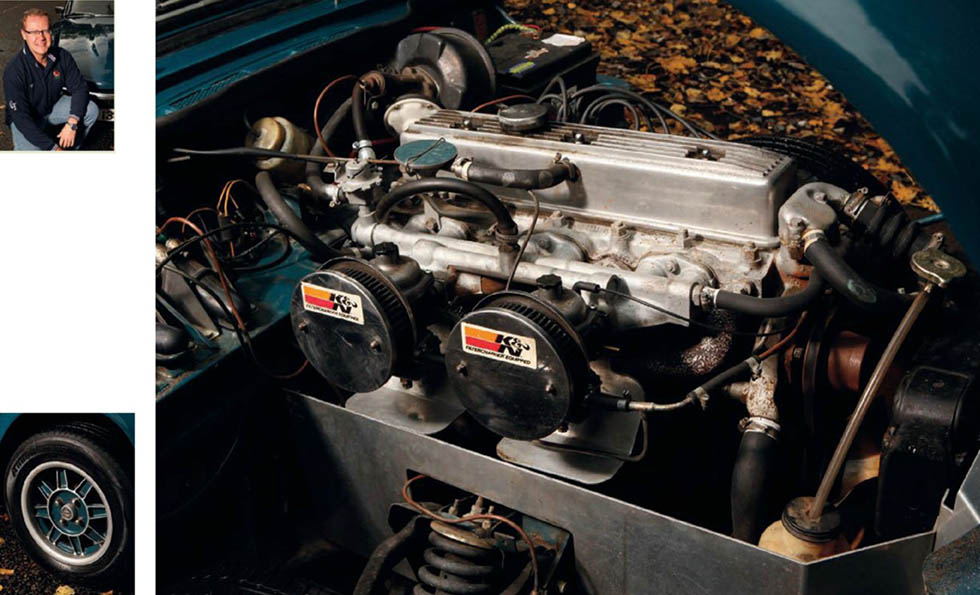
Clockwise, from right: Mk2 received a boost of 9bhp; side vents improved ventilation of cockpit compared to the original; second incarnation was introduced in 1968; note modern seats and bespoke door trim in this example; 175/70 R13 tyres on Cosmic alloy wheels.
Such practicalities are a bonus rather than the be-all and end-all, though. The fact remains that the simple mix-and-match premise of this car is one that carries an enduring appeal: take basic off-the-shelf components, add a powerful engine that makes all the right noises, and garnish with an attractive, flowing body. Perhaps it is fitting that the closest thing to a modern GT6 is built by the company that now owns the Triumph name – BMW, in the shape of its Z4 coupé.
The GT6 still offers something a little bit different, too – an individual choice from one of the most mainstream of marques. That’s not something you could say about the otherwise capable and handsome MGB GT. For the money, this is not a mix that you’re going to get elsewhere. Styling-wise, the Opel GT is up there but lacks the appeal of a six-cylinder engine, as does the less pretty but practical – and dynamically far superior – Lotus Elan +2.
Triumph came up with the GT6 during the prolific period following the launch of the Herald, in which the TR4, 2000, Vitesse and 1300 also appeared. Having been revived by Standard less than two decades earlier, it’s strange to think that the name would once again have disappeared only 11 years after the GT6 went out of production. Fortunately, the likes of Webster and Michelotti left us quite a legacy.
Thanks to Southern Triumph Services: 01202 423687; www.southerntriumph.com
‘IT REALLY DOES FEEL AS THOUGH YOU’RE IN SOMETHING WORTH FIVE TIMES AS MUCH’
THE OWNER Andy Carr
“About 18 years ago, I started a family and stopped motorcycling, so began looking for a classic. I wanted something different, not an MGB, and bought this after looking at three GT6s. Ten years ago, it broke a valve spring, and I thought it was an opportunity to do something different. I needed it to be usable because it was my daily driver, so Mark at Southern Triumph Services fitted a TR6 engine with heavier-duty gearbox. We also put twin-pot calipers on the front, with slotted and drilled discs. It had a new bonnet, too, and a lot of the back end rebuilt!
“Acceleration is really quite surprising, and there’s loads of torque. It has lots of excitement and drama – my daughters love it. If you’d bought it in 1971 you could have done all these things to it. The wheels, for example, are wider but were a period option.”
BUYING ADVICE Andy Cook
“Bodywork is most important,” says Cook, GT6 registrar for the Triumph Sports Six Club (www.tssc.org.uk). “Check floorpans, sills, arches and windscreen surrounds. And the chassis, too. The engine is pretty good, but beware of clutch problems, which could be dropped thrust washers allowing the crank to move backwards and forwards. It will damage the block if not fixed promptly. “The rubber Rotoflex couplings are very expensive and pattern ones don’t last. CV joint conversions are an alternative; they’re costly, but fit and forget.
“The Mk1 is probably the prettiest, but the Mk2 has more power and the improved rear suspension. The Mk3 is the most refined – the late ones even more so – while some body panels and interior trim are more readily available.
“They’re lovely looking cars, and easy to maintain. Values have been rising: you’ll spend £2000-3000 on a project, or £5000 for an MoT’d example needing work. Tidy ones are £8000-10,000, while a concours car with full history can be £15,000.”
‘THE GT6 OCCUPIED A NICHE FOR THOSE WHO COULDN’T STRETCH TO A JAGUAR E-TYPE’
THE OWNER Mike Titchen
“I’d always liked GT6s, but have owned all sorts over the years, from a Thames van to a Pontiac Firebird and Austin A35. I bought this one 23 years ago, having found it shivering in a garage!
It needed a gearbox but flew through the MoT. For a while, I used it all the time, but then it failed its MoT because of holes in the floor and it started from there. I did the floors, then moved on to the inner sills. “Mechanically, it’s been okay – all it’s had is an unleaded head – and in terms of miles covered, it’s on its second time around the clock. Trips to Le Mans have been a highlight – I’ve taken it round the circuit during the Classic meeting. I’ve even fabricated a ‘GT6’ trailer that it can pull. Last autumn, I took it to Zandvoort and this year I’ll be going to TriumphFest plus the Silverstone Classic for the anniversary celebrations.”
TECHNICAL DATA FILE TRIUMPH GT6 Mk1
Sold/number built 1966-1968/15,818
Construction steel chassis and body panels
Engine iron-block, alloy-head, ohv 1998cc ‘six’, twin Zenith-Stromberg carbs
Max power 95bhp @ 5000rpm
Max torque 117lb ft @ 3000rpm
Transmission four-speed manual with optional overdrive, driving rear wheels
Suspension independent, at front by wishbones, coil springs rear transverse leaf spring, swing axles, radius arms; telescopic dampers f/r
Steering rack and pinion
Brakes discs/drums
Length 12ft 1in (3683mm)
Width 4ft 9in (1448mm)
Height 3ft 11in (1194mm)
Weight 1904lb (863kg)
0-60mph 10.5 secs
Top speed 107mph
Mpg 26
Price new £985
Price now £5000-15,000
Mk2 (Where different)
Sold/number built 1968-’70/12,066
Max power 104bhp
Suspension rear reverse lower wishbones,
Rotoflex couplings
Price new £1148
Mk3 (Where different from above)
Sold/number built 1970-’73/13,042
Suspension rear (from Feb 1973) ‘swing
spring’ transverse leaf spring and swing axles
Length 12ft 5in (3785mm)
Width 4ft 101/2in (1486mm)
Weight 1936lb (878kg)
0-60mph 10.1 secs
Top speed 112mph Mpg 28
Price new £1287
‘WEBSTER WAS HOPING TO INCREASE THE SPITFIRE’S APPEAL WITH A COUPÉ VARIANT’
THE OWNER Neil Fletcher
“I decided that I wanted a classic and my son spotted this GT6 in 2007. I was sold! The guys who discovered it found it tucked behind a garage, covered in leaves. They wiped them off and, surprisingly, it was okay – the paint was fine. It didn’t have much history, though. It’s an April 1968 build with a 1972 plate and, according to the DVLA, had one owner from 1971-’98. I assume it went abroad new.
“It’s all standard apart from having a spin-off oil filter. Somebody had changed it to positive earth, so I switched it back, and it’s had a new dynamo recently. It needs some attention in places now, but I’ve had lot of fun with it. I’ve taken it to the continent – a universal joint failed on a trip to Spa – and it’s great for that. The load space is amazing – you can get two long holdalls in the back and still see out.”





